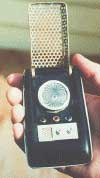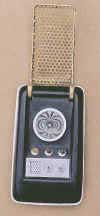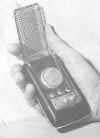The Classic Trek Communicators
By Richard A. Coyle
Next to the Classic Phaser, the Star Trek Communicator is one
of Science Fiction’s most popular props. This is also one of Trek’s most accurate predictions, the hand held communication
device. Back in the mid-sixties, the idea of such a technological marvel
was only a dream, but nowadays we think
nothing of a cell phone with caller ID,
custom ringing, light up activation, and even internet text readouts.
But in the make believe business of science fiction film and television,
it is a real challenge to conceive and create props that are even remotely as
far fetched and sci-fi-ish as the everyday gadgetry we take for granted. Moreover,
it is nearly impossible to make truly futuristic looking props. Alas, the days of the old winky blinky
LEDs are gone.
also one of Trek’s most accurate predictions, the hand held communication
device. Back in the mid-sixties, the idea of such a technological marvel
was only a dream, but nowadays we think
nothing of a cell phone with caller ID,
custom ringing, light up activation, and even internet text readouts.
But in the make believe business of science fiction film and television,
it is a real challenge to conceive and create props that are even remotely as
far fetched and sci-fi-ish as the everyday gadgetry we take for granted. Moreover,
it is nearly impossible to make truly futuristic looking props. Alas, the days of the old winky blinky
LEDs are gone.
 Star Trek’s classic years had some really great designs -- ones
that never really look too outdated. The
communicator is one of these. With
its black plastic body and flip-up grid antenna, speaker grill, three indicator
lights, and two knobs, it truly looks real, not unlike an actual mini walkie-talkie
radio.
And with the working twirling moiré running in a couple of close-ups,
the communicator really looked like something out of the future.
Star Trek’s classic years had some really great designs -- ones
that never really look too outdated. The
communicator is one of these. With
its black plastic body and flip-up grid antenna, speaker grill, three indicator
lights, and two knobs, it truly looks real, not unlike an actual mini walkie-talkie
radio.
And with the working twirling moiré running in a couple of close-ups,
the communicator really looked like something out of the future.
OK, enough prop worship. Here
is some real insider dope: the working moiré was run by a stopwatch. The
propmakers removed the lens and cover of a stopwatch and then mounted the bottom
disk to the second hand of the stop watch, which on an old analog piece ran
at ten rpm per second. When
started, round and round the moiré would spin, just a touch jerkily due to the
machined movement of the stopwatch as it ticked off each tenth of a second.
There are a few episodes that hint of this set-up. The
first is Number 50, "Patterns of Force,"
by
J.J.  Lucas, which aired in the second season on 2/16/67.
This is the famous episode where Kirk and Spock had to solve the problem
of a Star Fleet sociologist who had violated the Prime Directive and imposed the Nazi ruling system on a planet in order to
bring order to its society. There
they were captured, and their equipment was taken and disassembled to divine
the inner workings.
At one point, Mr. Spock had to reassemble a working communicator from
the parts of the two dissected units, and it is in this scene that you can see
the cut-out in the center frame that normally held the stopwatch. Rumor
has held that the only communicator that could be taken apart was one of the
"working" models. All
others were glued together, so evidently they took apart one of these hero pieces
to use it for this particular shot.
Lucas, which aired in the second season on 2/16/67.
This is the famous episode where Kirk and Spock had to solve the problem
of a Star Fleet sociologist who had violated the Prime Directive and imposed the Nazi ruling system on a planet in order to
bring order to its society. There
they were captured, and their equipment was taken and disassembled to divine
the inner workings.
At one point, Mr. Spock had to reassemble a working communicator from
the parts of the two dissected units, and it is in this scene that you can see
the cut-out in the center frame that normally held the stopwatch. Rumor
has held that the only communicator that could be taken apart was one of the
"working" models. All
others were glued together, so evidently they took apart one of these hero pieces
to use it for this particular shot.









